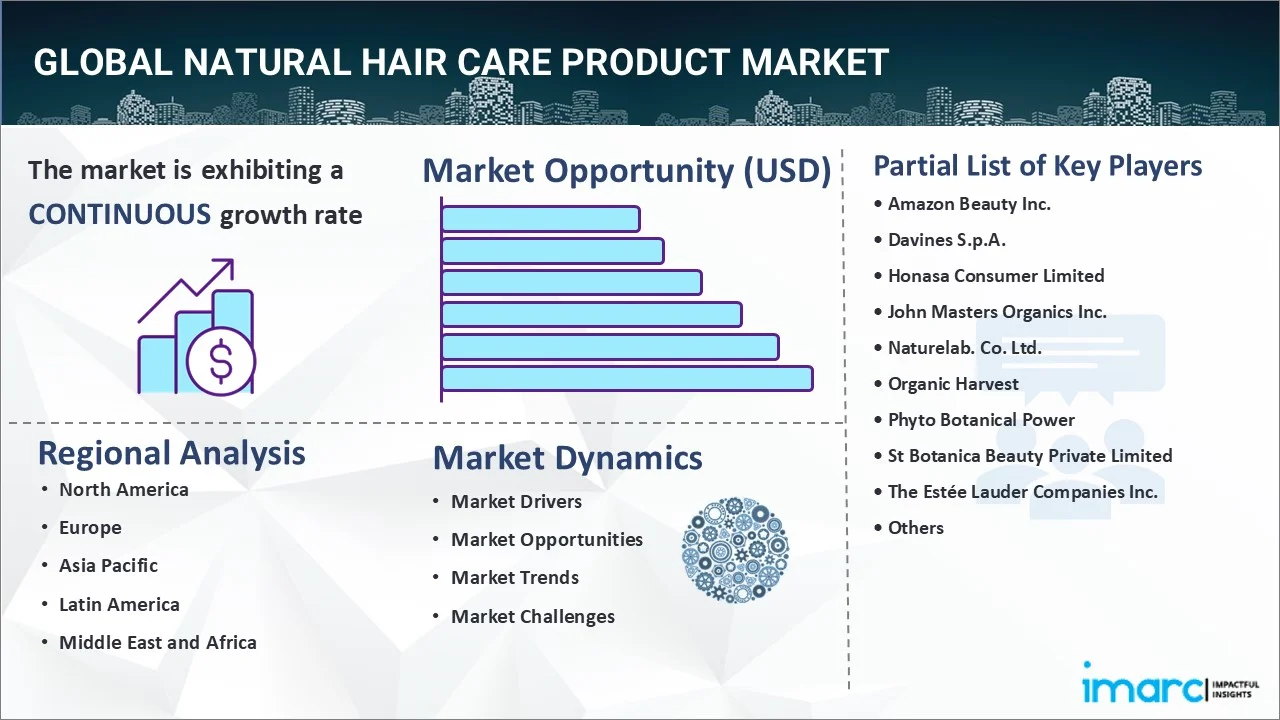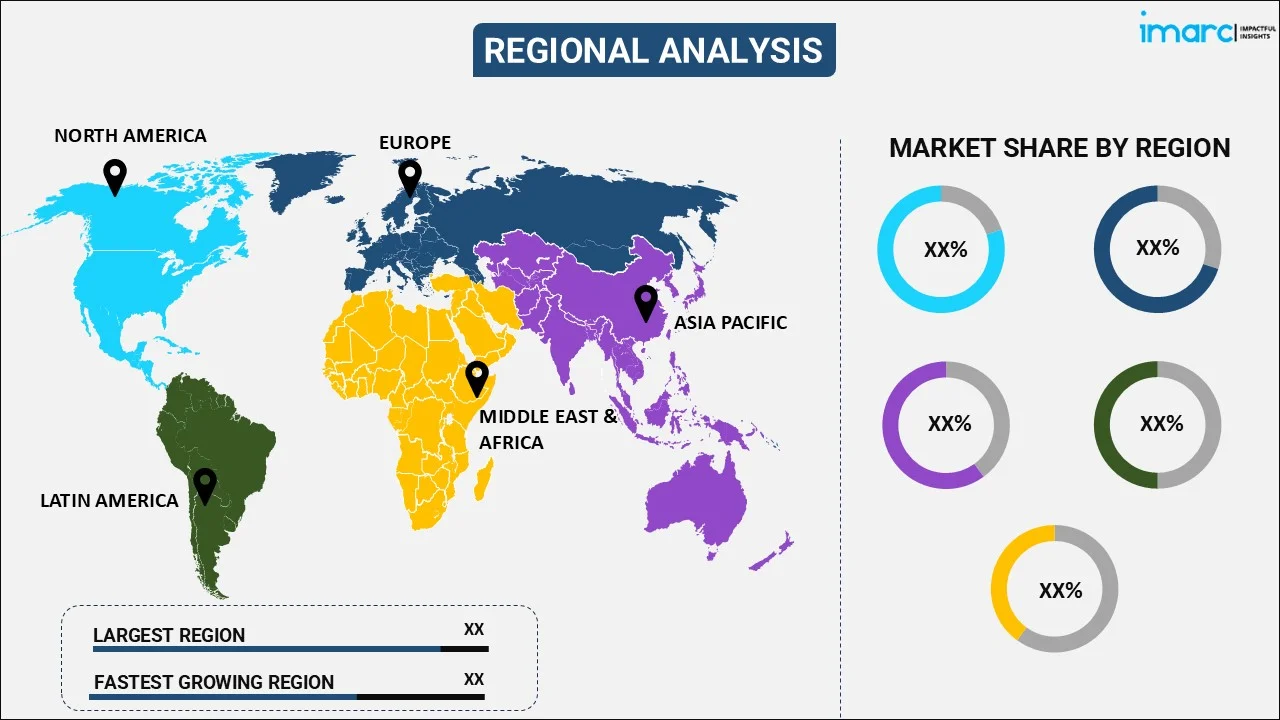
Natural Hair Care Product Market Report by Product Type (Shampoo, Conditioners, Hair Oil, Colorants, and Others), Distribution Channel (Online, Offline), End Use (Men, Women), and Region 2025-2033
Natural Hair Care Product Market Overview:
The global natural hair care product market size reached USD 11.7 Billion in 2024. Looking forward, IMARC Group expects the market to reach USD 17.8 Billion by 2033, exhibiting a growth rate (CAGR) of 4.55% during 2025-2033. The increasing demand for natural and organic products, rising expenditure capacities, and the growing environmental consciousness among the masses represent some of the key factors driving the market. At present, Europe enjoys the leading position in the market owing to the preference for sustainable products in the region.
|
Report Attribute
|
Key Statistics
|
|---|---|
|
Base Year
|
2024
|
|
Forecast Years
|
2025-2033
|
|
Historical Years
|
2019-2024
|
|
Market Size in 2024
|
USD 11.7 Billion |
|
Market Forecast in 2033
|
USD 17.8 Billion |
| Market Growth Rate 2025-2033 | 4.55% |
Natural Hair Care Product Market Analysis:
- Major Market Drivers: The market is experiencing moderate growth due to the increasing awareness about the harmful effects of synthetic chemicals in hair care products. Besides this, the growing focus on sustainable sourcing and environmental consciousness is positively influencing the market.
- Key Market Trends: The shift towards personalization and ingredient transparency in natural hair care products is gaining traction. Additionally, product innovations, such as vegan formulations and cruelty-free certifications, are key trends supporting the natural hair care product market growth.
- Geographical Trends: Europe leads the market because of the implementation of stringent cosmetic regulations and a strong preference for sustainable products.
- Competitive Landscape: Some of the major market players in the industry include Amazon Beauty Inc., Davines S.p.A., Honasa Consumer Limited, John Masters Organics Inc., Naturelab. Co. Ltd., Organic Harvest, Phyto Botanical Power, St Botanica Beauty Private Limited, The Estée Lauder Companies Inc., and The Procter & Gamble Company.
- Challenges and Opportunities: The high cost of natural ingredients and strict regulatory standards pose challenges for manufacturers. However, opportunities in developing affordable, sustainable products to meet the rising demand for natural and eco-conscious hair care solutions is bolstering the market growth.

Natural Hair Care Product Market Trends:
The increasing demand for natural and organic products across the globe is one of the key factors driving the market growth. Natural hair care products are widely used due to the rising consumer awareness regarding potential health risks associated with synthetic chemicals. In line with this, the widespread adoption of natural shampoos and conditioners, as they are great for the overall health of the hair and boost hair growth, is acting as another growth-inducing actor. Moreover, the rising consumer inclination toward natural hair care products due to the increasing side effects of using chemical-based shampoos and conditioners, such as bad hair quality and rough scalp, is favoring the market growth. Apart from this, the introduction of customized natural hair care products that cater to different hair types and needs is providing an impetus to the market growth. Additionally, the widespread product adoption due to the rising environmental consciousness among the masses regarding the impact of synthetic chemicals on health and the environment is propelling the market growth. Besides this, the launch of vegan natural hair care products manufactured without using animal-derived ingredients or byproducts is creating a positive outlook for the market. Furthermore, the growing concerns, such as hair fall, dull hair, lack of hair volume, and thinning hair, are providing a considerable boost to the market growth. Other factors, including the rising expenditure capacities of consumers, the emerging e-commerce industry, increasing advertising campaigns and celebrity endorsements, and the implementation of various government initiatives to promote natural products, are anticipated to drive the market growth.
Key Market Segmentation:
IMARC Group provides an analysis of the key trends in each segment of the global natural hair care product market, along with forecasts at the global, regional, and country levels from 2025-2033. Our report has categorized the market based on product type, distribution channel, and end use.
Product Type Insights:

- Shampoo
- Conditioners
- Hair Oil
- Colorants
- Others
Hair oil accounts for the majority of the market share
The report has provided a detailed breakup and analysis of the natural hair care product type market based on the component. This includes shampoo, conditioners, hair oil, colorants and others. According to the report, hair oil represented the largest segment.
Hair oil holds the biggest share in the market due to its versatile benefits, including nourishment, hydration, and scalp health. Individuals are prioritizing hair oils made from natural ingredients as they are seen as safer and more effective in promoting hair strength and growth compared to synthetic alternatives. Natural hair oils, such as coconut, argan, and almond oils, are preferred for their nourishing properties, helping to address issues like dryness, frizz, and hair loss. The rising demand for chemical-free and plant-based oils is driven by the growing awareness about scalp care and hair wellness, which is leading to the popularity of oils infused with essential nutrients.
Distribution Channel Insights:
- Online
- Company Owned Websites
- E-Commerce Websites
- Offline
- Specialty Stores
- Supermarkets and Hypermarkets
Offline holds the largest share of the industry
A detailed breakup and analysis of the natural hair care product market based on the distribution channel has also been provided in the report. This includes online (company owned websites, and e-commerce websites), and offline (specialty stores and supermarkets and hypermarkets). According to the report, offline accounted for the largest market share.
Offline (specialty stores and supermarkets and hypermarkets) represents the largest segment due to the convenience and in-store experience it offers. Buyers prefer purchasing natural hair care products through these physical retail outlets because of the ability to personally evaluate products, such as testing textures and scents, and receiving in-store expert advice. Specialty stores, in particular, are popular for offering a curated selection of high-quality, natural brands, while supermarkets and hypermarkets benefit from a broad buyer base and convenient access. This segment continues to dominate as it caters to a wide range of buyer preferences and provides an immediate, tangible shopping experience.
End Use Insights:
- Men
- Women
Women is the predominant market segment
The report has provided a detailed breakup and analysis of the natural hair care product market based on the end use. This includes men and women. According to the report, women represented the largest segment.
Women represent the largest segment, driven by the growing awareness about hair health and a strong preference for organic and chemical-free products. Women are seeking products that cater to specific hair types, textures, and concerns like damage, frizz, or thinning, making them the primary target for brands in this industry. The rise of social media influencers and beauty bloggers focusing on natural hair care are also played a vital role in driving the demand. Furthermore, women tend to experiment more with different hair care routines, which encourages higher spending and product diversity in this segment.
Regional Insights:

- North America
- United States
- Canada
- Europe
- Germany
- France
- United Kingdom
- Italy
- Spain
- Others
- Asia Pacific
- China
- Japan
- India
- South Korea
- Australia
- Indonesia
- Others
- Latin America
- Brazil
- Mexico
- Others
- Middle East and Africa
Europe leads the market, accounting for the largest natural hair care product market share
The report has also provided a comprehensive analysis of all the major regional markets, which include North America (the United States and Canada); Europe (Germany, France, the United Kingdom, Italy, Spain, and others); Asia Pacific (China, Japan, India, South Korea, Australia, Indonesia, and others); Latin America (Brazil, Mexico, and others); and the Middle East and Africa. According to the report, Europe was the largest market for natural hair care product.
Europe accounts for the majority of the market due to the high individual awareness about organic and eco-friendly products, as well as stringent regulatory standards that favor natural formulations. People in the region are inclined towards sustainable and chemical-free hair care solutions, which is driving the demand for products made with organic and ethically sourced ingredients. According to the natural hair care industry statistics, Europe’s leadership in adopting clean beauty practices further solidifies its dominance in the market. In 2023, UK-based brand UpCircle entered the haircare market with a new natural Shampoo Crème, which offered three times the washes of traditional liquid shampoos. This vegan, cruelty-free product was made with upcycled pink berry extract and nourishing oils like coconut and lavender, and was housed in recyclable, refillable packaging.
Competitive Landscape:
The report has also provided a comprehensive analysis of the competitive landscape in the global natural hair care product market. Competitive analysis such as market structure, market share by key players, player positioning, top winning strategies, competitive dashboard, and company evaluation quadrant has been covered in the report. Also, detailed profiles of all major companies have been provided. Some of the companies covered include:
- Amazon Beauty Inc.
- Davines S.p.A.
- Honasa Consumer Limited
- John Masters Organics Inc.
- Naturelab. Co. Ltd.
- Organic Harvest
- Phyto Botanical Power
- St Botanica Beauty Private Limited
- The Estée Lauder Companies Inc.
- The Procter & Gamble Company
Kindly note that this only represents a partial list of companies, and the complete list has been provided in the report.
Report Coverage:
| Report Features | Details |
|---|---|
| Base Year of the Analysis | 2024 |
| Historical Period | 2019-2024 |
| Forecast Period | 2025-2033 |
| Units | Billion USD |
| Scope of the Report | Exploration of Historical and Forecast Trends, Industry Catalysts and Challenges, Segment-Wise Historical and Predictive Market Assessment:
|
| Product Types Covered | Shampoo, Conditioners, Hair Oil, Colorants, Others |
| Distribution Channels Covered |
|
| End Uses Covered | Men, Women |
| Regions Covered | Asia Pacific, Europe, North America, Latin America, Middle East and Africa |
| Countries Covered | United States, Canada, Germany, France, United Kingdom, Italy, Spain, China, Japan, India, South Korea, Australia, Indonesia, Brazil, Mexico |
| Companies Covered | Amazon Beauty Inc., Davines S.p.A., Honasa Consumer Limited, John Masters Organics Inc., Naturelab. Co. Ltd., Organic Harvest, Phyto Botanical Power, St Botanica Beauty Private Limited, The Estée Lauder Companies Inc., The Procter & Gamble Company, etc. |
| Customization Scope | 10% Free Customization |
| Post-Sale Analyst Support | 10-12 Weeks |
| Delivery Format | PDF and Excel through Email (We can also provide the editable version of the report in PPT/Word format on special request) |
Key Questions Answered in This Report:
- How has the global natural hair care product market performed so far, and how will it perform in the coming years?
- How big is the natural hair care product market?
- What are the drivers, restraints, and opportunities in the global natural hair care product market?
- What is the impact of each driver, restraint, and opportunity on the global natural hair care product market?
- What are the key regional markets?
- Which countries represent the most attractive natural hair care product market?
- What is the breakup of the market based on the product type?
- Which is the most attractive product type in the natural hair care product market?
- What is the breakup of the market based on the distribution channel?
- Which is the most attractive distribution channel in the natural hair care product market?
- What is the breakup of the market based on the end use?
- Which is the most attractive end use in the natural hair care product market?
- What is the competitive structure of the global natural hair care product market?
- Who are the key players/companies in the global natural hair care product market?
Key Benefits for Stakeholders:
- IMARC’s report offers a comprehensive quantitative analysis of various market segments, historical and current market trends, market forecasts, and dynamics of the natural hair care product market from 2019-2033.
- The research study provides the latest information on the market drivers, challenges, and opportunities in the global natural hair care product market.
- The study maps the leading, as well as the fastest-growing, regional markets. It further enables stakeholders to identify the key country-level markets within each region.
- Porter's five forces analysis assist stakeholders in assessing the impact of new entrants, competitive rivalry, supplier power, buyer power, and the threat of substitution. It helps stakeholders to analyze the level of competition within the natural hair care product industry and its attractiveness.
- Competitive landscape allows stakeholders to understand their competitive environment and provides an insight into the current positions of key players in the market.
Need more help?
- Speak to our experienced analysts for insights on the current market scenarios.
- Include additional segments and countries to customize the report as per your requirement.
- Gain an unparalleled competitive advantage in your domain by understanding how to utilize the report and positively impacting your operations and revenue.
- For further assistance, please connect with our analysts.
 Inquire Before Buying
Inquire Before Buying
 Speak to an Analyst
Speak to an Analyst
 Request Brochure
Request Brochure
 Request Customization
Request Customization




.webp)




.webp)












